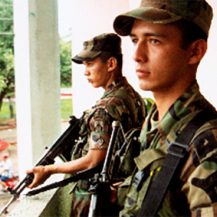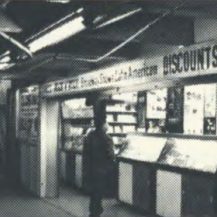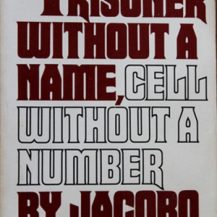Contested Country: An Examination of Current Propaganda Techniques in the Colombian Civil War
In recent years the Colombian state and security forces have deployed the most elaborate propaganda campaigns in the rural sector.
This text originally published: 15 August 2005
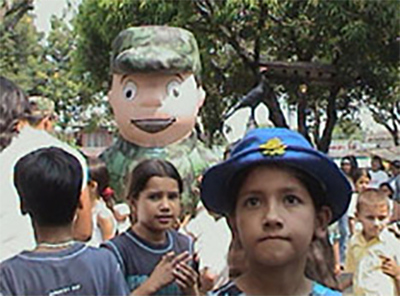
Introduction
Colombia’s civil war has spanned more than four decades. Its roots lie in the incomplete project of creating the Colombian state after the 19th Century defeat of Spanish colonialism, and in the 20th Century political rivalries of two elite political parties whose increasingly violent internecine feuds—referred to simply as la Violencia—ignored the backwardness and socioeconomic marginalization of Colombia’s rural poor, for whom the state was largely a distant abstraction only occasionally visited upon them. Colombia’s government has never controlled all of the Colombian territory, in part due to the country’s rugged geography of soaring Andean mountain ranges and dense Amazonian jungles.
In addition to the local and national dynamics of struggles over power, land, and wealth distribution, the Colombian civil war’s longevity has imbued the conflict with characteristics of the paradigmatic shifts in the hemispheric and global order, from Cold War rivalries between Communism and Capitalism, through the U.S.-led “war on drugs” and neoliberal globalization, to the present organizing principle of the “war on terror.” During the sweep of Colombia’s long war, revolutionary forces have rallied, fought, and disbanded, while other actors have become entrenched in the fight for the long haul.1 Precisely because the Colombian conflict has continued unabated throughout these shifts, it has become a hybrid of ideological battlefields, creating a rich environment for propaganda. For instance, by targeting just one of the country’s leftist guerrilla groups, the Colombian state can simultaneously claim to fight Communism, drugs, and terror while furthering its state-building project. Needless to say, such situations are rare in the world today.
While the Colombian state and security forces—and to a lesser extent the illegal armed groups—have a broad array of propaganda tools and techniques at their disposal, the underdeveloped infrastructure and isolation of huge swaths of Colombia’s rural hinterlands, where much of the conflict is being fought, does not lend itself to sophisticated propaganda. Thus, while remaining feasible propaganda strategies for urban areas, tools such as websites and televisions have limited reach in rural areas where electricity and telephone lines are either inexistent or frequent targets of insurgent attacks. Similarly, any propaganda transmitted through newspapers and magazines does not project far from the urban seats of the media outlets that publish such periodicals, especially in light of widespread illiteracy and the marginal profitability and risk involved with transiting print media into the rural sector.
As a result, waging effective propaganda in Colombia’s rural conflict zones has required the development and implementation of more direct, on-the-ground techniques. While all the armed actors use propaganda and obtain collateral propagandistic results from their actions, in recent years the Colombian state and security forces have deployed the most elaborate propaganda campaigns in the rural sector, and have consequently been the most effective actors at conveying their message. This study analyzes the propaganda techniques currently being used by various armed actors in Colombia’s rural regions, with particular emphasis on state techniques.
My primary focus is neither the content of these various actors’ messages, nor the relative merits of these groups’ ideologies or activities. Rather, my analysis specifically focuses on the means by which their messages are transmitted; I hope to return to the content of the groups’ messages in future research. Much of my analysis is based on my first-hand observation in two of Colombia’s primary rural conflict zones: the eastern department of Arauca (June 2003) and the southern department of Caquetá (February 2004). In both areas, I visited rural towns and villages where Colombian state forces were in the process of consolidating control after dislodging guerrilla forces that had long held sway in these areas.2 While there are undoubtedly regional variations and nuances, I submit that the techniques outlined in this analysis are echoed and employed throughout much of the country. I have also drawn on relevant academic analysis and media reports throughout my examination.
What is Propaganda?
In modern society, the term “propaganda” immediately elicits feelings of suspicion, distrust, or manipulation by powerful interests. As historian Philip Taylor demonstrates, this negative perception of propaganda is a relatively recent phenomenon: “[B]efore 1914, propaganda simply meant the means by which the converted attempted to persuade the unconverted.”3 Pejorative connotations of the term, Taylor argues, came about during the First World War, when “atrocity propaganda” began to be applied in a calculated, almost scientific manner in order to provoke predictable emotional responses from the wartime public.4 Taylor suggests that “It is when propaganda is employed in the service of violence, however, that we begin to mistrust it, because it encourages people to kill people, or to acquiesce in that slaughter.”5 Despite its openness to abuse, Taylor argues that propaganda is a neutral process, defining it as “the deliberate attempt to persuade people to think and behave in a desired way.”6 He adds that, “what distinguishes propaganda from all other processes of persuasion is the question of intent.”7
Sociologist Jacques Ellul, whose scientific study of propaganda informs most other explorations of the topic, points out that analyzing propaganda is difficult, since it is regarded by most as an “evil” and because it is generally a secretive action.8 Ellul’s broad definition of propaganda identifies four core components:
Psychological action: The propagandist seeks to modify opinions by purely psychological means; most often he pursues a semi-educative objective and addresses himself to his fellow citizens.
Psychological warfare: Here the propagandist is dealing with a foreign adversary whose morale he seeks to destroy by psychological means so that he begins to doubt the validity of his beliefs and actions.
Re-education and brainwashing: Complex methods of transforming an adversary into an ally which can be used only on prisoners.
Public and human relations: These must necessarily be included in propaganda… because they seek to adapt the individual to a society, to a living standard, to an activity. They serve to make him conform, which is the aim of all propaganda.9
More narrowly, Ellul defines propaganda as “techniques of psychological influence combined with techniques of organization and the envelopment of people with the intention of sparking action.”10 Ellul emphasizes that “Propaganda must be total. The propagandist must utilize all of the technical means at his disposal…”11 In this regard, Ellul echoes another influential analyst (and a practitioner) of propaganda, Edward Bernays.
Bernays served in the U.S. government’s Committee for Public Information during the First World War, and later, his contributions to the business of molding public opinion earned him the moniker “the father of public relations.” In his 1928 book, Propaganda, Bernays noted the negative connotations of the word “propaganda,” calling it “the executive arm of the invisible government.” Power dynamics aside, Bernays’ definition is quite simple: “The mechanism by which ideas are disseminated on a large scale is propaganda, in the broad sense of an organized effort to spread a particular belief or doctrine.”12 Like Ellul, Bernays stressed the totality of propaganda: “There is no means of human communication which may not also be a means of deliberate propaganda… The important point to the propagandist is that the relative value of the various instruments of propaganda, and their relation to the masses, are constantly changing.”13
Bernays’ point is an important one. Just about anything can serve as propaganda, but some techniques and methods are more effective than others. In the intense and unpredictable environment of low-intensity conflict like Colombia’s, where the competing sides seek to win over the “hearts and minds” of an embattled and encircled public, effective propagandists must adapt to changing circumstances and deploy only the techniques that yield worthwhile returns in terms of public opinion.
In all these definitions and analyses, propaganda is examined almost clinically. Judgments on the morals and ethics are left aside. I happen to disagree with Taylor’s assertion that propaganda is neutral, since the message is very much the purpose of propaganda, and the message cannot be neutral. However, I mostly concur with Taylor’s position that “propaganda analysis demands objectivity if it is to be undertaken effectively.”14 In the interests of furthering our understanding of propaganda in Colombia, this short study focuses on the methods employed, leaving aside most value judgments. Further research would reveal the extent to which the propaganda message of the various parties in Colombia’s conflict are valid, truthful, erroneous, or deceptive. Perhaps it is worth recalling the words of a man whose very name has become synonymous with concerns about propaganda and the perversion of power, George Orwell, who shrewdly observed, “All propaganda lies even when it tells the truth.”15
Main Participants in the Conflict
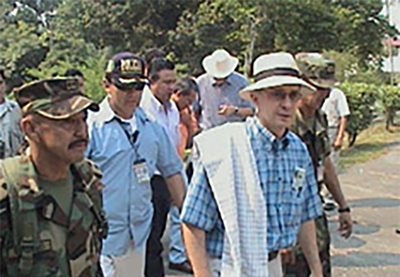
President Uribe (with towel) on a tour of a recently retaken Colombian village, 2004. Photo: Colombian Army
Before analyzing some of the propaganda methods currently used in Colombia, a brief introduction to the key national players in the Colombian civil war is necessary. The Colombian state and security forces are headed by the president, Alvaro Uribe Vélez. Uribe, a former governor of the relatively affluent Antioquia department, won a landslide victory in 2002 by running on an unassailable promise of “security with democracy” and “security for all Colombians.”16 Uribe’s predecessor, Andres Pastrana, had overseen collapsed peace talks with the country’s largest insurgency, and by 2002 the electorate, alarmed by rising violence (some of it attributable to the state itself), was ready for a hard-line approach. While Uribe has delivered the hard-line approach by ramping up military campaigns, security remains elusive in Colombia, as is evidenced by continued displacement and violence. Uribe has also demonstrated authoritarian tendencies, such as his decision to create special zones where elected civilian officials were replaced by unelected military leaders.17 Bookish in appearance, Uribe is a tireless campaigner, crisscrossing Colombia for public appearances that have long hinted at his desire to serve a second consecutive term as president, despite constitutional constraints on doing so. Polls suggest Uribe has maintained an approval rating of approximately 70 percent.
The Colombian military and national police are the main branches of the state security forces, and are both administered by the Ministry of Defense. The national police are chiefly responsible for maintaining order in cities and towns, as well as on some roads. They also oversee much of the state’s anti-narcotics activities. Owing to the all encompassing nature of the civil war in Colombia, the national police are also well-armed; in the rural sector, they frequently reside in sandbagged barracks. The Colombian military (predominantly the army) plays a significant role in enforcing security, especially in the rural sector. The military is also responsible for the bulk of the state’s counterinsurgency activities, and has targeted the country’s leftwing guerrilla forces relentlessly. The military has had an inconsistent position on fighting the rightwing paramilitaries, which it helped set up in the 1980s (when militias were legally permitted extra-state security organs).
Hounded by implications of collusion with the since-outlawed paramilitaries and charges of involvement in human rights abuses, the military has recently begun to target the paramilitaries, though not yet with anything near the intensity aimed at the guerrillas. The recipient of substantial U.S. military aid, training, and logistical support, the Colombian military is large (with some 180,000 troops in the army alone) and formidably armed. Since 2003, the military has reinvigorated its campaign to conquer guerrilla-held regions of the countryside—estimated to be 40 percent of the total area of Colombia—under a major new offensive dubbed Plan Patriota.
Originally formed in the 1980s at the behest of large landholders, local politicos, and drug cartel members threatened by guerrilla kidnapping campaigns, Colombia’s rightwing paramilitaries initially served as private—and legally recognized—security forces. They frequently worked with the logistical support and the active participation of the Colombian military, carrying out an increasingly aggressive “social cleansing” campaign against suspected guerrillas and their alleged supporters. Although outlawed in 1989, the paramilitaries continued their activities, often with collusion from members of the Colombian state security forces. In 1997, Colombia’s disparate paramilitary forces unified in a loose umbrella organization, the United Self-Defense Forces of Colombia (AUC), and soon expanded to become a major fighting force with a nationwide presence.
The AUC gained notoriety in the late 1990s for a string of massacres, before switching tactics to one-off assassinations in order to minimize negative publicity. Its continued violence and its heavy involvement in the drug trade have put the AUC in the sights of the Colombian state, though factions of the military continue to value the AUC’s ability to carry out desired actions “off the record.” Funded largely by payments from affluent allies and its involvement in the drug trade, the AUC is presently engaged in a (partially observed) cease-fire and seeks amnesty through negotiations with the Colombian government. Many view demobilization of the AUC’s approximately 18,000 fighters as a precursor to the group’s emergence as a political party. The U.S. State Department holds the AUC responsible for 70 percent of Colombia’s human rights abuses, and added the group to its list of Foreign Terrorist Organizations in 2001.
Founded in 1964, the Revolutionary Armed Forces of Colombia (FARC) came out of various peasant militias that had sought to protect themselves from the violent clashes of the two elite political parties during the Violencia period of the late 1940s and 1950s. Soon after its birth, the FARC established fronts in rural sectors throughout the country, implemented agrarian reforms, and adopted a Communist revolutionary project. Its strength concentrated in impoverished rural areas, the FARC got involved in the drug trade in the late 1970s, levying taxes on coca crops grown by peasants in regions it controls. Aside from its “war tax” on drugs, the FARC funds itself through extortion and kidnapping for ransom, tactics that have cost it most of the support it once enjoyed among segments of the Colombian public that thought the FARC might emerge as a progressive political party should peace negotiations ever prove successful.
The FARC has also built a militia presence in urban areas, and is capable of raids and ambushes in most areas of the country, especially along inter-city roads; meanwhile, its urban bombings and use of crude gas cylinder projectiles have drawn it considerable scorn. The FARC has been involved in several peace negotiations, including a mid 1980s period when it formed a political party that was subsequently decimated by assassinations. Its most recent peace negotiations (1998-2002) included the state’s recognition of a cease-fire zone under FARC control in the southern Caquetá department; the principal towns of the zone were overrun by state forces after the collapse of the peace talks. The FARC remains a potent force of some 18,000 fighters with operational capacity throughout Colombia, and has shown a propensity for patiently awaiting opportune moments to launch renewed attacks. The U.S. State Department placed the FARC on its inaugural Foreign Terrorist List in 1997.
Inspired by the Cuban Revolution and Catholic Liberation Theology, the National Liberation Army (ELN) is a smaller leftwing guerrilla group founded in 1964 by radical university students and later joined by several Catholic priests. It has a Communist revolutionary platform and is concentrated in rural areas in the northern half of the country. The ELN has funded itself through kidnapping and extortion, avoiding the drug trade on ethical grounds. The ELN has sometimes allied with the FARC, but tends to pursue its own line. With about 4,000 active combatants, the ELN’s relatively limited role in the conflict is nonetheless amplified by the havoc it has wreaked on the country’s petroleum sector through repeated bombings of oil infrastructure; oil is Colombia’s top licit export. The ELN has been seeking a negotiated end to hostilities for several years, to little avail. The U.S. State Department has listed the ELN as a Foreign Terrorist organization since 1997.
No list of participants in Colombia’s civil war would be complete without mentioning the Colombian public. Caught between the ideological extremes of the armed actors outlined above, the Colombian people are the main victims of the conflict. In addition to the war-related deaths of some 3,000 civilians per year, over 2.5 million Colombians have been forcibly displaced by the violence and insecurity since 1996.18 Compounding this social upheaval is the economic disaster in which 55 percent of the population lives below the poverty line.19 An overwhelmingly young country, most of Colombia’s population has never experienced peace.20
In the struggle for the hearts and minds of the Colombian public, all manner of propaganda have been deployed. Though my analysis focuses largely on propaganda in Colombia’s rural sector, I begin with a discussion of two passive forms of propaganda used by all the armed actors: colors and websites.
National Colors
In the context of a complex civil war, the national colors—yellow, blue, and red—have been adopted by armed actors on all sides of the conflict, while drab green military uniforms are worn by not just the state army, but its police, their sometime allies in the rightwing paramilitaries, and the two largest leftwing guerrilla insurgencies (combatants of the latter three also routinely dress in civilian clothing due to their status as illegal armed groups and in order to blend in with the population at large).

Colombia's flag
The Colombian flag is a horizontal tricolor topped by a broad yellow band, then a narrower blue band, then a red band equal in size to the blue one. It goes without saying that state agencies and security forces incorporate the flag and national colors in their seals, symbols, uniforms, and insignia. More interesting are the varied uses of the national colors by the other armed groups.
The AUC uses the state flag and national colors in its uniforms and symbols; uniformed AUC fighters tend to wear armbands with the acronym of their particular paramilitary bloc in white letters on a black field, with small patches of the national flag sewn to their upper sleeves. The FARC also uses the national colors in its insignia, and has designed a revolutionary flag that superimposes a black-outlined, white-field in the shape of the Colombian territory over the standard national flag; a depiction of two black rifles form an X in the center of the state outline. When in their full dress uniform, FARC guerrillas also wear armbands featuring the Colombian national colors. The ELN uses the classic Marxist revolutionary colors of red and black in most of their symbols, often eschewing the national colors; uniformed ELN combatants wear unmarked black balaclavas or hoods, or sometimes black and red handkerchief masks and similar armbands with the group’s acronym written in white letters; the handkerchief mask is a variant of the ELN’s revolutionary flag, a horizontal bicolor topped by a red band then a black band, with a white “ELN” centered in the field.
The use of the national colors by all sides (with the general exception of the ELN) reflects the conflict’s status as a civil war where Colombia itself is ostensibly at stake. Moreover, Colombia’s national colors date back to the independence struggle against the Spanish Crown, when a member of Simon Bolivar’s liberation army designed a yellow, blue, and red tricolor.21 Since all parties in Colombia’s conflict hold Bolívar and the independence struggle in a positive light, there is no contradiction in all sides adopting the national colors.
Websites
All of Colombia’s armed actors have launched websites.22 As alluded to earlier, the websites of the armed groups are not particularly useful propaganda tools in the infrastructure-poor rural areas of Colombia. Internet access is sporadic or altogether nonexistent in rural areas. But in a climate where Colombian journalists run tremendous risks entering rural areas and encountering representatives of the illegal armed groups, websites have emerged as an important conduit for the transmission of information not just to the internet-surfing public, but also to media organizations.
The websites of the Colombian President and the state security forces, in addition to hosting sub-sections on laws, organizational structure, statistics on various themes, and biographical profiles of key officials, are also designed to supply very frequent updates by conveying a steady stream of official press releases. The President’s website, for instance, prominently displays a daily photo of Uribe’s latest speaking engagements alongside core passages of his speeches and links to audio excerpts. The site also highlights government-prepared filings on topics like crime levels and new policy initiatives.
The website of the national police runs releases on the latest crimes broken up and criminals captured—arrested drug processors, seized cocaine, captured counterfeit materials—and stories highlighting public order activities—police protection of bridges or schools, or rescues of kidnap victims. The army’s website presents a gung-ho face, frequently displaying images of killed or captured enemy combatants under headlines such as, for example, “Two FARC Terrorists Out of Battle in Antioquia.” Accompanying stories by press units in the various brigades reveal the details of how the fighters were felled and what they were carrying when they died (more on this point later). The military’s site also has prominent links to sections on its humanitarian programs and respect for human rights; in comparison with U.S. military websites, recruitment is not emphasized because Colombia has conscription.
The websites of the illegal armed groups are neither as dynamic nor as flashy as those of the official organs of state, but they do communicate many of the same core points: political position statements, press releases, and information about the history and organization of the groups. The AUC’s website features releases, editorials, commentaries on topics like political economy and human rights, and even an mp3 of the AUC anthem. There are also links to the websites of the various blocs that make up the AUC; all AUC-affiliated sites share a “newsy”, text-heavy look that downplays the militancy of the organization (though this may be a function of the ongoing negotiations with the government, as before the talks AUC sites featured anti-guerrilla comics and online games, too).
The FARC’s streamlined website conveys communiqués, interviews, open letters, and releases, with sub-sections about topics like the participation of women and students. The FARC site also publishes the group’s legal codes. The FARC has spent more energy than other groups attempting to make (parts of) its site multilingual, perhaps a reflection of its attempts to counter the almost uniformly negative press coverage it receives within and outside of Colombia. The ELN’s site is the most basic in design terms, but contains the requisite communiqués, press releases, and interviews with ELN leaders. It is set up as an online magazine called Insurrección, volumes of which can be viewed in HTML or downloaded in PDF or Microsoft Word formats.
These websites are admittedly a passive form of propaganda for the bulk of the population, in that they require a visitor to actively engage them, rather than the other way around. However, by providing frequent updates on the conflict, the websites serve a propaganda purpose by transmitting the armed groups’ official information; Ellul would most likely consider them a form of psychological action propaganda, based on their attempts to address and “educate” the public at large.
Information published on these groups’ websites—especially those of the state bodies—is often picked up by information-starved media outlets. As Edward Herman and Noam Chomsky have pointed out, government “bureaucracies turn out a large volume of material that meets the demands of news organizations for reliable, scheduled flows.” Moreover, government sources “also have the great merit of being recognizable and credible by their status and prestige.”23 This prestige factor, combined with the high frequency with which the state and security forces’ websites are updated, ensures them primacy in the press over the information transmitted via the websites of the illegal armed groups.
An Analysis of Selected Forms of Rural Propaganda
Earlier, I pointed out that the underdevelopment of Colombia’s rural sector has necessitated a hands-on approach to propaganda in these areas. Inadequate infrastructure aside, it must be noted that Colombia’s rural regions are absolutely central to the state’s economic development model. Colombia’s four largest exports—illicit coca, and licit petroleum, coal and coffee—are all produced in rural areas. Ranching, agriculture, and mining—all crucial to the Colombian economy—are likewise predominantly rural activities. The economic importance of Colombia’s rural sector has meant that the countryside has been the frequent site of armed confrontation in the civil war. Much of the violence and most of the displacement in Colombia occurs in small rural towns and villages where the Colombian state has historically had a weak presence, if it was present at all, and where distrust of the central government in distant Bogotá runs deep.24 With this contextualization in mind, I now turn to a discussion of some of the propaganda techniques currently being used in Colombia’s rural sector.
Graffiti

A trucked graffitied by the ELN guerrillas. Photo: Garry Leech
Graffiti is a mild form of propaganda employed particularly by the illegal armed groups. Commonly used in cities, graffiti finds its way into the rural sector in a variety of ways. In rural towns and villages, buildings and objects are often tagged with the name and perhaps a slogan of the armed group (or the bloc/front of the group) that controls a given area. In contested towns, graffiti marks can serve as territorial demarcation lines much like the tags used by U.S. urban gangs. Rural armed groups also graffiti vehicles, which become mobile symbols of the tagging group’s presence or power, especially if the vehicle then crosses lines and penetrates enemy territory. While undoubtedly awkward—and potentially dangerous—for the drivers of such vehicles, graffiti on vehicles—or on buildings—is not a particularly effective or action-inducing form of propaganda.
A variant on graffiti is the mural. Typically painted on the exterior walls of buildings, murals are favored by the guerrillas, who draw inspiration from Latin America’s long history of leftwing political murals (Che Guevara’s portrait is a popular image). The military has painted over guerrilla murals and graffiti with its own artwork; one reporter witnessed soldiers on patrol in an ELN-controlled barrio in Saravena, Arauca paint a sunny day mural over ELN tags.25
Threats
Threats—transmitted by word-of-mouth or through other communiqués—serve an obvious propaganda purpose in Colombia’s conflict. Usually directed at civilians, threats are an extreme form of psychological warfare (as Ellul defines it), since they seek to break the morale of “enemy” forces. Simply put, threats are an expression of a particular armed group’s displeasure or distrust of the threat recipient(s), and serve as signals to individuals to either change behavior or suffer the invariably harsh consequences. Typically, threats brand the recipient as a collaborator or sympathizer—or even an active member—of the sending group’s enemy. For example, a threat faxed to the mayor of Tame, Arauca, by a FARC unit identified him and other local government officials, medical personnel, ranchers, and others by name as “military targets,” branding these individuals as “narcoparamilitaries infiltrated among a poor people seeking a way to live in a dignified manner.”26 Threats are a relatively localized form of propaganda employed by the armed groups, and their impact is limited; however, if threats are acted upon in the form of disappearances, killings, and massacres, they take on a significantly more pronounced propaganda purpose.
Disappearances, Killings and Massacres
Well-documented reports show that all of Colombia’s armed actors—the state forces as well as the illegal armed groups—have committed and continue to commit killings and massacres of innocent civilians.27 (A massacre is defined as the simultaneous slaughter of three or more people in the same place and for the same reason. Disappearances—often an intermediary status for before the victim turns up dead—are quite similar in effect, and are not analyzed in detail here, except to note that they generate their own acute agony for close relations of the victims, who often do not know their loved one’s fate for extended periods of time.) While deliberate, targeted killings and massacres of civilians are a reprehensible aspect of Colombia’s civil war, it is exceedingly clear that these actions serve a propaganda purpose to the groups that commit them.
Without doubt, massacres and killings serve militarily strategic purposes—however shameless or hollow—beyond mere propaganda: they eliminate alleged enemies or collaborators, they prompt displacement which clears territory for the expansion of elite interests, they carry out “justice” (ajusticiar, to bring justice, is a Colombian colloquial synonym of asesinar, to murder), they show a group’s ability to match its enemy’s ferocity quid pro quo, and so on.28 But in propaganda terms, the foremost purpose of killings and massacres is to send a sharp message to survivors—relatives, acquaintances, neighbors, even entire villages—that the armed actors can and quite possibly will strike with unrestrained severity.
Considering the fact that the vast majority of killings and massacres go unpunished in Colombia, the impunity of the killers only serves to reinforce the original message; not only are victims ruthlessly slaughtered, but their killers remain at large, and probably nearby. Though Ellul might be uncomfortable with categorizing them as such, I believe that, in the context of Colombia’s war, massacres and killings essentially function as a most extreme and crude form of psychological warfare; as a technique of propaganda, they certainly bring new meaning to Bernays’ observation that “[t]here is no means of human communication which may not also be a means of deliberate propaganda….”29 This point warrants further exploration, but essentially, the message is simply one of power relations—the killers have power, and victims and survivors are powerless.
As researcher Robin Kirk has noted, for several decades Colombia has “spoken” in a perverse vocabulary, the language of killing and post-mortem mutilation. There is no stronger evidence of the propagandistic use of killings and massacres than the various mutilations developed less to harm victims themselves than to haunt surviving witnesses of the carnage. The notorious Colombian necktie, in which the victim’s tongue is pulled through a deep cut beneath the jaw and left dangling on the chest, or the flower vase cut, in which the victim’s dismembered limbs and decapitated head are stuffed into the stump of the neck, both gained prominence during la Violencia and remain in the vocabulary of the armed groups, particularly the paramilitaries.
In more recent years, victims’ genitalia have been stuffed in their mouths, pregnant women have had their fetuses cut from their wombs, and large groups of civilians have been hacked or cut apart by machetes and chainsaws. Sometimes, bodies were then arranged for maximum visual effect. In Kirk’s words, “The point, of course, was not just to kill, but to communicate. The blood-splattered tableau mort was meant to demonstrate that there were absolutely no limits to what would be done.”30
This orgy of violence inverts the concept of “atrocity propaganda” common to the arsenal of the propagandist who, seeking to build the cause for war, stirs the emotions of his people with lurid descriptions of atrocities committed by the enemy.31 In Colombia, while massacres and killings have certainly backfired as a form of propaganda, the atrocity has also been used as a means of communicating a group’s “sincerity” and strength. The AUC built its fierce reputation largely on its persistent commission of—and claims of responsibility for—massacres. Only after it had achieved its desired level of prominence and political leverage did the AUC shift away from massacres in favor of targeted, one-off killings that draw much less media coverage and public scrutiny.32
State forces are understandably hesitant to overtly use massacres for propaganda purposes in the manner of the AUC, but have found ways to make the dead talk: its victims, sometimes dressed post-mortem in fatigues, are routinely presented to public eyes as “guerrillas killed in combat.”33 The FARC has not missed out on the medium of massacres, either. In addition to rural killings, on Inauguration Day 2002, the FARC launched several of its notoriously inaccurate gas cylinder missiles over the skies of Bogotá. It knew full well the chances of killing the new president or other top officials were slim to none, but nonetheless took the opportunity to demonstrate its ability to strike at the heart of the Colombian state, killing at least 14 people in poor outlying areas where the projectiles landed.
In recent years, the bluntness of the massacre has been increasingly discarded in favor of targeted assassinations, but even in single killings, the overall effect remains the same.
The State’s Rural Counterinsurgency Propaganda
As mentioned earlier, the state and its security forces are the most effective propagandists in Colombia. The Colombian Army, in particular, has become well-versed in the vocabulary of psychological operations, or psy-ops—partially as a result of its training by U.S. Special Forces detachments in Colombia and at the U.S. Army’s School of the Americas (renamed in 2000, in a psy-op of its own, as the Western Hemisphere Institute for Security Cooperation). As the state forces enter and occupy regions of rural Colombia long under the sway of the guerrillas, they are deploying a “hearts and minds” propaganda campaign that relies more on human interaction than on high-tech tools. At the same time, state authorities collect images and information about their successes, which are then passed to the national media for transmission to the Colombian public.
The following sections detail some of the key techniques of the state’s rural counterinsurgency propaganda, as I witnessed during the army’s Operación Nuevo Año in the southern department of Caquetá—long a FARC stronghold—in February 2004.
It is important to note that rural Colombians have tended to adjust to life under a given armed group as long as that group remained the unchallenged authority in a given region; it is at the point when regions are contested that violence—and displacement—surge.34 Thus, in the immediate aftermath of the Colombian military’s successful seizure of a town or village once held by the guerrillas, much of the population of that community will flee; they do so either out of fear of reprisals from the conquering state forces (frequently accompanied by the arrival of the AUC) or because they are forced to leave by the guerrillas. But since the Colombian military’s overriding mission in guerrilla-controlled areas is ultimately one of state-building, the state forces begin immediate efforts to “cleanse” the scene and coax back the residents, if possible.
Clean-Up and Coverage
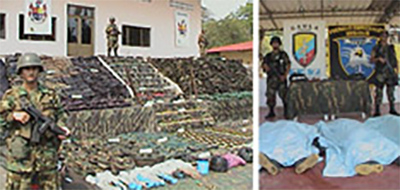
Colombian soldiers pose with captured materiel and the bodies of dead FARC fighters, 2004. Photos: Colombian Army
Once a conquered town is secured, alleged members of the guerrillas captured during the fighting are photographed and detained.35 As some soldiers search for bombs or other booby traps, other soldiers or members of the Colombian state intelligence agency, the Administrative Department of Security (DAS), interview any remaining residents and take videos and photographs of the surroundings, including battle damage and any dead enemy combatants. Invariably, enemy weapons or war materiel captured by the state forces are sorted and arranged for photographs with jocular soldiers standing guard over the rows of bullets, two-way radios, pistols, and other war booty. Soldiers frequently pose with the corpses of killed enemy combatants, too. Within a short time, selected images are incorporated into official press releases that include hyper-detailed accounts of all seized materials and captured or killed enemy combatants.36 These are soon passed to members of the Colombian and international press.
Within weeks, if security conditions hold, the army may arrange press junkets, flying or driving in selected members of the press to inspect the cleansed town. For example, the army captured La Unión Peneya, Caquetá on 4 January 2004; on 25 January a first-hand write-up of the town appeared on page A-14 of the Washington Post, a Colprensa story including army photos hit Colombian papers the same week, and an English-language Associated Press story followed a few days later.37
Independent reporting is not helped by the generalized hostility of the armed actors toward the press, and Colombian journalists in particular have been ruthlessly targeted by the various sides in the conflict. Colombia routinely ranks as one of the most dangerous countries in the world for journalists, and often the only way for reporters to gain access to conflict zones is with a military escort. This de facto embedding of the press corps offers the state considerable influence on what stories get reported and how. As the editor-in-chief of El Tiempo, Colombia’s leading daily, told the BBC, “To move in these regions we have to ask permission from the army. You go in as a group and you try to do your job. You even have to confront the armed groups to say ‘Are you going to let us do our job?’ It is always risky. You never know what is going to happen.”38
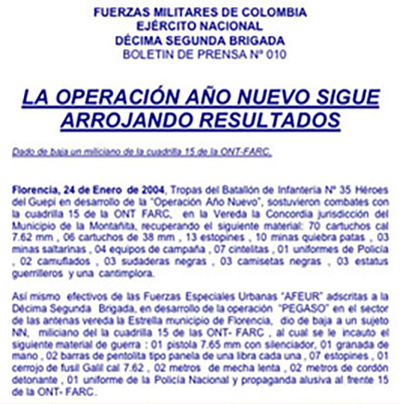
A Colombian Army press release about a recent confrontation with the FARC guerrillas
While the press is correct to follow such stories through whatever channels possible, over-reliance on the military for access to conflict zones, and on official sources for details about combat operations, gives press coverage of Colombia’s war an unmistakably state-leaning bent; it grants the state what Herman and Chomsky, in their critique of mass media, have called a “filter,” an opportunity to frame perceptions.39 This, in turn, necessarily serves the propaganda needs of the state, fostering an image—however selective and subjective—of persistent progress in its counterinsurgency effort. It bears repeating that photos of confident-looking Colombian soldiers standing guard over dead guerrilla fighters covered by sheets, with captured equipment arranged by the corpses, are a mainstay in official propaganda, and the Colombian press is not squeamish about presenting such images.
Hearts and Minds
Aside from taking careful steps to document its victories and project them to the Colombian public at large, as the state forces consolidate their grip, they build up a security presence by stationing extra police and military units in town. The army refers to this process as “Integrated Action.” An army officer in charge of coordinating these activities in Tame, Arauca, explained, “The specific mission converges in two areas. One is the military presence… including attacking the illegal groups, be they guerrillas, self-defense groups, or militias in the town center, and also narcotraffickers… Aside from our military operations, we also have to work on psychological operations. These essentially say to the community, ‘We must invest in security in order to have social progress, because without security no one invests.’”40 In another article, I have analyzed the aforementioned security measures.41
Below, I detail several of the psy-ops the military uses to build support among the local populations of towns and villages they have recently taken over. These various techniques correspond to two forms of propaganda as described by Ellul: psychological action which aims to alter public opinion through more and less subtle didactic measures, and also public or human relations, which seek the people’s integration into, and acculturation to the presence of, the state.42
Early in the process, the army creates and broadcasts (often via its own stations) radio spots encouraging recently displaced residents to return to their homes. Radio is perhaps the only mass media technology with any reach in rural areas, since battery-powered radios are commonplace. These short announcements, backed by peppy military brass music, sound an optimistic tone as they deliver a message emphasizing the shared struggle for peace and security—a ubiquitous theme in state propaganda.
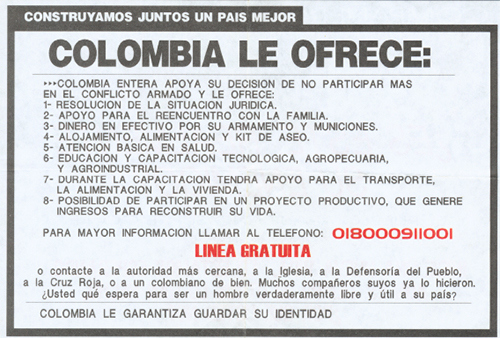
An army flyer offering enticements to would-be defectors from the illegal armed groups.
Radio spots, posters, flyers, and other materials are also aimed at members of the illegal armed groups. In addition to winning over local civilians, the state forces actively seek to provoke the desertion of enemy combatants; Ellul refers to this strategy as psychological warfare. State authorities offer a long list of enticements—for example, help reunifying with family members, job training, cooking kits, cash in exchange for trading in weapons—to guerrillas or paramilitaries willing to desert. While attrition rates seem to be on the rise as a result of these efforts, continued rural violence, displacement, and economic disparity also make useful recruitment propaganda for the illegal armed groups; many would-be deserters from the guerrillas and paramilitaries also lack confidence in the state’s ability to protect them from their former comrades in arms.

Costumed soldiers try to win hearts and minds, El Paujil, Caquetá, 2004. Photo: Colombian Army
While attempting to sway deserters, the military also works to fosters a sense of “the helping hand of the state” by offering food handouts and setting up tents where local residents can visit military doctors or get free haircuts. Soldiers chum around and smile with the locals, building up relationships on a personal level as they try to deflate the tension residents feel in the aftermath of conflict flare-ups so close to home. A military band may be brought in, while soldiers dressed as cartoon characters entertain the children.
One of the Colombian state’s most explicit, and more interesting, psychological operations is its attempt to appeal to the hearts and minds of children in rural conflict zones. As Philip Taylor notes, “Although much modern propaganda appeals to reason, it is more usually felt to play on emotion, with the young being particularly vulnerable to such emotional manipulation.”43 In the army’s Soldier for a Day program, area youngsters are shuttled to local army bases where they are exposed to propagandistic indoctrination disguised as fun treats and activities.44 These “soldiers for a day,” as young as five-years-old, get to swim in the base’s pool, ride on armored personnel carriers, and wear camouflage headbands and face paint. At the same time, soldiers dressed as clowns dole out candy as army psychologists encourage the children to speak openly about any people they know or suspect to be guerrillas. Similar activities have been brought to the streets of contested neighborhoods in rural towns, with machine gun-toting soldiers escorting soldiers armed with sacks of candy and dressed as clowns as they go door to door seeking to “befriend” local children. In the towns of Colombia’s war-torn rural sector, it is undoubtedly the case that some of these children do have relatives who are supporters or even members of the army’s enemies.
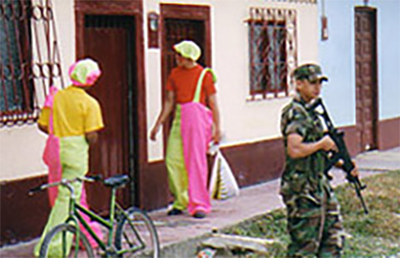
Clowns, candy, and a call for children's cooperation from the Colombian army. Photo: Garry Leech
While the army’s tactics toward children may yield useful bits of actionable intelligence, they also play on the innocence of children in a repugnant manner. The propaganda value of these techniques is also questionable, as the experience of children socializing with soldiers they may otherwise fear could clearly be off-putting. However, the Colombian military evidently feels that the children’s association of candy, clowns, and soldiers may yield long-term loyalty in regions where local residents began to interact with state authority only recently.
Conclusion
A recurrent theme in the definitions of propaganda put forth by Taylor, Ellul, and Bernays is the issue of intent. In Colombia’s intractable war, intent is not always clearly discernible. The goals of the guerrillas, the project of the paramilitaries, and the policies of the state have been warped, diluted, and reoriented over the decades of war; at times, the swirl of violence exposes inconsistencies too obvious to ignore: Can a massacre win support for the perpetrators? Can the military be allies with and enemies of the paramilitaries at the same time? Can kidnappers create a just society? Is the route to peace through endless war?
If the propaganda techniques I have outlined above seem inadequate to answer these ponderous questions, perhaps it is because the war has become self-perpetuating and no longer needs a consistent system to organize intent, persuasion, and action. Perhaps the competing cacophony of the often incompatible claims and counterclaims of the armed groups has made propaganda a meaningless diversion in a war that just goes on and on, fed by ludicrous levels of foreign aid, astronomical drug wealth, and a culture where the rule of reason is trumped repeatedly by the regime of the gun. And yet, propaganda still serves a purpose in Colombia. As new generations are born into the conflict, as the violence touches people in long-isolated areas, and as ordinary Colombians try to balance feelings of fear, grief, anger, anguish, and confusion, propaganda is there to offer an answer, even if rarely the right answer.
Notes
Links were functional at the time of original publication.
1. For instance, the M-19 guerrillas took up arms in 1972. After several years of unconventional and often urban militancy, the group disarmed in 1989 to form a political party.
2. Specifically, my first trip occurred in June 2003, to Tame, Arauca. Some of my research from that trip was summarized in an article entitled Araucan Nightmare: Life and Death in Tame, August 2003. My second trip was in February 2004, to Florencia, El Paujil, and Bolivia, in Caquetá, as well as Puerto Asís and Santana, Putumayo. This trip coincided with the early stages of “Operation New Year,” the forerunner to Plan Patriota, a massive military campaign to penetrate areas of southern Colombia long controlled by the FARC. The 2004 trip also informed my articles, Civilian ‘Collaborators’ in Colombia’s Conflict, March 2004 and Washington Has Lost Its Way in Colombia, August 30, 2004.
3. Taylor, Philip M. Munitions of the Mind: A History of Propaganda from the Ancient World to the Present Era. Manchester: Manchester University Press, 1995. p. 4
4. Taylor, p. 3
5. Taylor, p. 5
6. Taylor, pp. 5-6. The italics are Taylor’s.
7. Taylor, p. 7
8. Ellul, Jacques. Propaganda: The Formation of Men’s Attitudes. New York: Alfred A. Knopf, 1965. Translated by Konrad Kellen and Jean Lerner. p. x
9. Ellul, p. xiii
10. Ellul, p. xiii
11. Ellul, p. 9
12. Bernays, Edward. Propaganda. New York: IG Publishing, 2004 (first ed. 1928) p. 48
13. Bernays, p. 161
14. Taylor, p. 6
15. I thank Professor Nina Khruscheva of the New School University for bringing Orwell’s quotation to my attention.
16. Quote cited in BBC News online profile of President Uribe, available at: http://news.bbc.co.uk/
1/hi/world/americas/1996976.stm
17. For more on President Uribe’s authoritarian tactics, see my article, Uribe Administration Impeding Foreign Press, November 25, 2002.
18. CODHES figures http://www.codhes.org.co/
cifra/GraficoTendencias1985_2005.jpg
19. Figures are a 2001 estimate from CIA World Fact Book, 2001. Available at: http://www.nationmaster.com/country/
co/Economy
20. According to the CIA World Fact Book, 31 percent of the Colombian population is under 14 years of age, and U.S. Census Bureau-generated population pyramid diagrams show Colombia’s current and projected age distribution to be heavily skewed to the young. See: http://www.nationmaster.com/country/
co/Age_distribution
21. The independence army’s flag was the basis of the flag of the post-independence Great Colombian Federation, from which Colombia, Ecuador, and Venezuela emerged as individual countries in the 1830s; for this reason they share the same national colors. The various historical flags can be viewed at http://www.z6.com/
z6files/z6files/fotw/flags/co-gran.html.
22. The Colombian President’s website is: http://www.presidencia.gov.co/. The Ministry of Defense’s website is: http://www.mindefensa.gov.co/. The Colombian Army’s website is: http://www.ejercito.mil.co/. The National Police’s website is: http://www.policia.gov.co/. The AUC’s website is: http://www.colombialibre.org/; several of its constituent blocs also have their own websites. The FARC’s website is: http://www.farc-ep.ch/. The ELN’s website is: http://www.eln-voces.com/. The descriptions of these websites are my impressions based on regular visits to the sites, and were current as of May 2005. As is the nature of the web, design overhauls are possible and unpredictable.
23. Herman, Edward S. and Noam Chomsky. Manufacturing Consent: The Political Economy of the Mass Media. New York: Pantheon, 1988. p. 19
24. Leech, Garry. Killing Peace: Colombia’s Conflict and the Failure of U.S. Intervention. New York: Information Network of the Americas, 2002. p. 7
25. See Garry Leech’s article, Informers for a Day, April 7, 2003.
26. Quote from a fax sent by the Alfonso Castellanos Mobile Column of the FARC-EP to Mayor Jorge Bernal of Tame, Arauca, June 9, 2003. Fax is in the author’s possession.
27. For one of many reports detailing the abuses committed by the various armed actors, see Human Rights Watch. War Without Quarter: Colombia and International Humanitarian Law. New York: Human Rights Watch, 1998.
28. Kirk, Robin. More Terrible Than Death: Massacres, Drugs, and America’s War in Colombia. New York: Public Affairs, 2003. p. 30
29. Bernays, p.161
30. Kirk, pp. 26-27
31. Taylor, p. 3
32. The AUC’s tactical shift is discussed by Jason Howe in his article Interview with an Assassin, February 9, 2004.
33. Human Rights Watch, War Without Quarter, pp. 60-70
34. For a more detailed analysis of this point, please see the section called “Colombia’s Shifting Front Lines” in my article Civilian ‘Collaborators’ in Colombia’s Conflict.
35. An officer from the Colombian Army’s 12th Brigade assured me that members of the FARC are easy to differentiate from civilians “because they carry revolvers.” Author’s interview at Headquarters of the Army’s 12th Brigade, Florencia, Caquetá. February 2004.
36. For example, a press release from the 12th Brigade described the killing of three FARC combatants under the headline, “Operation New Year Continues Producing Results.” The following extract from the release details items said to be on the body of one of the slain FARC fighters: “01 7.65mm pistol with silencer, 01 hand grenade, 02 bars of pentolita [type of explosive], 07 estopinas [type of detonator], 01 bolt from a 7.62 caliber Galil rifle, 02 meters of slow-burning wick, 02 meters of fuse, 01 National Police uniform, and propaganda related to the 15th Front of the Terrorist FARC.” The cumulative effects of such statistics is a powerful impression that the enemy is being whittled away, fighter by fighter, bullet by bullet.
37. Wilson, Scott. “Colombia Targeting Rebel Strongholds,” Washington Post, January 25, 2004, p. A-14. “No nos moverémos de este pueblo” Colprensa, January 29, 2004. Martinez, Margarita. “Violence Turns Village Into Ghost Town,” Associated Press, February 1, 2005.
38. Enrique Santos Calderon, El Tiempo Editor-in-Chief, interview entitled “Silenced by the Gun,” on the BBC News website, May 3, 2005. Available at: http://news.bbc.co.uk/
2/hi/americas/4507047.stm. Calderon also emphasizes the necessity of using highly mobile, non-local reporters to avoid danger, saying, “We never have the local correspondent cover sensitive issues. We send someone from Bogotá, who does the work and returns immediately. If he stays he will be singled out and subjected to some kind of oppressive measure.”
39. Herman and Chomsky, p. 2
40. Author’s interview with Capt. Paredes, Colombian Army 18th Brigade, Navos Pardo Battalion, Tame, Arauca, June 10, 2003.
41. See my article, Araucan Nightmare: Life and Death in Tame.
42. Ellul, p. xiii
43. Taylor, p. 9
44. See Leech, Informers for a Day.
This article originally appeared in Colombia Journal, an online journal that was published by the Information Network of the Americas (INOTA).
Submitted as paper for:
New School, Graduate Program in International Affairs
'Media and the Politics of Propaganda', Spring 2005, Professor Nina Khrushcheva
